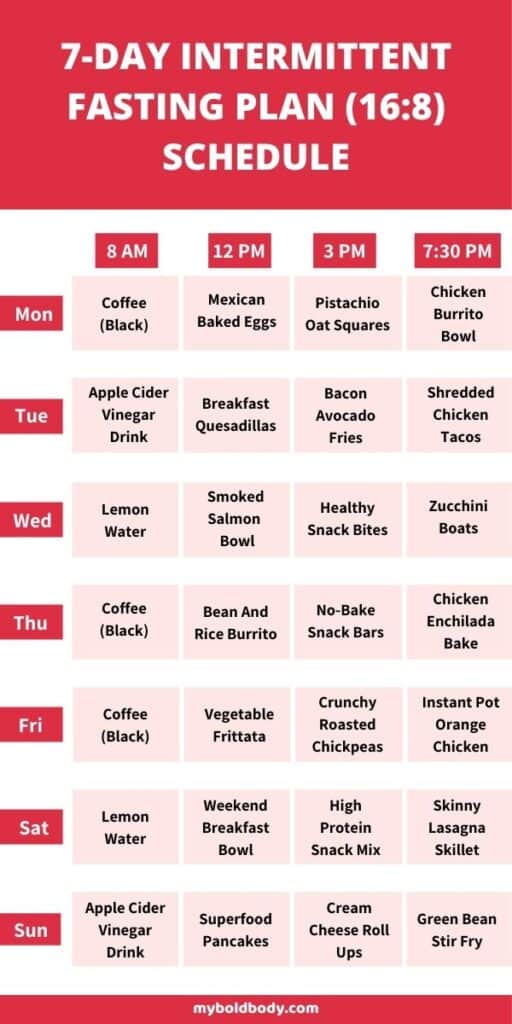This post may contain affiliate links. For more info, please read our full disclosure here
Intermittent fasting, a pattern of eating which alternates between being in a fed and fasted state, has become quite popular in recent times.
By limiting food intake to a certain time window, it boasts of several health benefits, including weight loss.
Although there are several ways to go about it, the 16:8 seems to be the most popular method most people use today.
This post will explain what intermittent fasting (IF) is, how it works and how to do it, as well as a simple 7 day IF meal plan to help you get started right.
Let’s dive in.
What Is Intermittent Fasting?

Simply put, intermittent fasting is an eating pattern, which involves limiting your food intake to a certain period of time, which allows your body enter into a “fasted state” where it burns body fat for fuel.
IF is more like a style of doing things, rather than a diet, which focuses more on the “when you eat” rather than on the “what you eat”. And it has become quite popular recently, and with very good reason.
IF offers many health benefits when practiced right. This can range from weight loss, to improved cholesterol, blood sugar and so on.
How IF works
The concept of IF is somewhat simple. By limiting your food intake to a certain time window, two things tend to take place.
The first is that you end up eating less. Unless you’re on a secret mission to consume as much food as humanly possible, by limiting food intake to a certain period of time, you’ll find that you’ll end up eating less than you would on a regular day.
If you focus on eating to satiety (which you generally should), then there’s obviously a limit to the amount of food you can consume within a certain period of time.
The other way IF works is by letting your body utilize its fats stores in the fasted state.
Here’s the thing. When you eat food, insulin goes up, and your body starts to break down the food for energy. The required energy (or calories) are used as you go about your usual activities and the excess is stored away for later use.
When insulin goes down, your body turns to the “excess energy” it stored earlier in your fat cells. In the fasted state, your insulin levels are usually lower, which encourages your body to turn to its reserves, and start burning fat for energy.
Types Of Intermittent Fasting
As simple as IF sounds, there are actually several ways to do it. Although some methods are more popular and more preferred than others, and some variations exist between individual types, these are the main types of IF
The 16:8 fast
You might have already guessed this one, since it is the most popular one. The 16:8 method or daily fast, involves limiting all food intake with a caloric value to an 8-hour window, while fasting for the remaining 16 hours of the day.
It seems to be the easiest and most preferred, since sleep hours technically count as fasting hours. So if you sleep about 8 hours a day, you’re already half-way there.
The meal plan given later on in this article is based on the 16:8 method.
The 5:2 method
Unlike the 16:8 method that handles the fasting on a more daily basis, the 5:2 method handles fasting on a more weekly basis.
It involves eating regularly for 5 days, and strictly limiting your calorie intake to about 500 calories for women, and 600 for men, for the remaining 2 days.
Please note that the 2-day fast is not meant to be consecutive. For example you could eat normally on Monday and Tuesday, fast on Wednesday, resume normal eating on Thursday and Friday, and then fast on Saturday. Something like that.
Eat stop eat method
Similar to the 5:2 method, the eat stop eat method takes things a step further. It involves eating regularly for 5 days, and then fasting completely for 2 days. Again, the 2 days are not meant to be consecutive.
Take for example you eat regularly from Monday till Tuesday, then fast from the dinner of Tuesday evening till the dinner of Wednesday evening, and then resume regular eating till your next 24 hour fast.
Alternate day fasting
This involves alternating between days of regular eating, and days of fasting. Fast days can range from eating nothing of significant caloric value, to eating thing only up to 500 calories.
Health Benefits Of Intermittent Fasting

Weight Loss
Weight loss is one of the major reasons most people decide to jump on the IF bandwagon, and for a lot of people, it seems to deliver good results.
First by helping us eat less overall without needing to count calories, and then by allowing the body go into the fasted state where it burns fat for fuel, it sure has the potential to promote weight loss.
Several studies, like this one and this one, show that IF can serve as an important tool for people trying to lose weight.
But it doesn’t just end there. While losing weight, a bit of muscle mass is expected to be lost in the process as well.
However, when compared to regular calorie restriction, IF may be able to help preserve more muscle mass while aiding fat loss.
Disease Prevention
Apart from losing weight, IF may also help protect against some certain diseases, ranging from type-2 diabetes to high blood pressure and even cardiovascular diseases.
This study shows how IF can help reduce cardiovascular disease risk while promoting weight loss. Being in a fasted state every once in a while, even if not for the sake of weight loss seems to be a good thing.
Improved Cognitive Function
Intermittent fasting doesn’t just provide physical benefits alone. It can also provide certain mental benefits.
Although we only have animal studies for now, IF has shown to be able to improve the production of a protein in the nerve cells, known as brain-derived neurotrophic factor, or BDNF.
This helps with memory, learning and other important cognitive functions. Overall, IF supports brain health and better cognitive function.
16:8 Intermittent Fasting – What To Eat

Unlike regular diets, intermittent fasting focuses more on when you should eat, rather than on what you should eat.
But for people who want the best results, it may help to include several things in your plate, and likewise, avoid certain types of food.
While counting calories isn’t necessary in intermittent fasting, you might want to make sure you’re filling your plate with healthy whole nutritious foods, rather than other unhealthy foods.
Making sure your body is getting the right nutrients it needs will do you good when you’re in the fasted state.
Fruits and veggies, whole grains, healthy fats, nuts, seeds and lean sources of protein are generally recommended, since they can better keep you satiated during your fast.
What To Drink
What you drink during IF is pretty important as well, since most people start their day with a drink.
Generally, it is advised to only consume drinks without any reasonable caloric value, or else you end up breaking your fast. Drinks like soda, alcohol and fruit juices are a no-no, and will end your fast.
On the other hand, you can enjoy drink like water, tea, and coffee (black) since they have little to no caloric value.
For most people, they may like to add a thing or two to their drinks to spice things up. While this is very understandable, you still need to be careful, since certain additives can turn your calorie-free drink into a calorie-laden one.
Adding a few teaspoons of apple cider vinegar for example, is a great idea. Also, a few drops of lemon (emphasis on “few”) might not be a bad idea as well. However, sugar, cream or milk are not the best additives to use because they’ll break the fast.
(16:8) 7-Day IF Meal Plan

This is a sample 7-day meal plan, based on the 16:8 strategy, where you fast for 16 hours and have an eating window of 8 hours.
It is worth noting however, that certain people may find it difficult to sustain a fast for 16 hours. If you fall into such categories, don’t worry. Here are some tips that might help you along the way.
1) Make sure you get enough fiber and lean protein. Since fiber, like protein can help suppress appetite, getting enough can keep you satiated for longer.
2) Try to ease into it. If this is your first time with IF, odds are you might find it a bit difficult. If a 16 hour fast seems too much for you, you can try a 13 or 14 hour fast and gradually work your way up from there.
3) Try not to consume too much refined carbs during your eating window. Refined carbs, due to their glycemic index, can cause blood sugar spikes and crashes, which will only leave you uneasy and craving food, and could mess up your fast.
These are just a few of my personal tips I believe will help you along the way, if you want to try intermittent fasting for weight loss. Now, here are some recipes you’ll love.
Brunch Recipes

- One Skillet Mexican Baked Eggs | Via: Domestic Superhero
- Simple Breakfast Quesadillas | Via: Cookie And Kate
- Healthy Weekend Breakfast Bowls | Via: Brunch On Sunday
- Bean and Rice Burrito | Via: Plant-Based On A Budget
- Creamy Barley and Smoked Salmon Brunch Bowl | Via: Whole Food Bellies
- Easy Vegetable Frittata | Via: Primavera Kitchen
- Healthy superfood pancakes | Via: Domestic Gothess
Dinner Recipes

- Chicken Burrito Bowl | Via: Damn Delicious
- Healthy Sriracha Shredded Chicken Tacos | Via: Jar Of Lemons
- Burrito Zucchini Boats | Via: Delish
- Healthy Chicken Enchilada Bake | Via: Elizabeth Flinch Wellness
- Instant Pot Orange Chicken | Via: Sweet And Savory Meals
- Skinny Lasagna Skillet | Healthy Fitness Meals
- 30-Minute Sesame Chicken Green Bean Stir Fry | Via: Ambitious Kitchen
Snack recipes

- Pistachio Oat Squares | Via: Love And Lemons
- Bacon Avocado Fries | Via: Delish
- Healthy Snack Bites | Via: Pip And Debbie
- No Bake Snack Bars | Via: Sweet Peas And Saffron
- Crunchy Roasted Chickpeas | Via: Joy Food Sunshine
- High-Protein Snack Mix | Via: My Modern Cookery
- Vegetable Cream Cheese Roll Ups | Via: Rachael Cooks
Summing It All Up
Intermittent fasting has proven to be a very useful tool for weight loss and healthy living when done right, and it offers a lot of health benefits too.
There are lots of ways and methods to do IF, although the 16:8 method is the most popular. If you’re new to IF or trying to get started, this simple beginner’s guide and 7-day intermittent fasting meal plan will help you along the way.
Don’t forget to save this post and share with your friends.
Cheers.